In Situ Airtightness Measurement Using Compressed Air Flow Characteristics
Abstract
:1. Introduction
2. Numerical Method
2.1. Transient Method
2.2. Fan Pressrization with Blower Door
3. Outline of the Field Measurement
3.1. Experimental Equipment
3.2. Description of Experimental Buildings
4. Results and Discussion
4.1. Experimental Results in Case A
4.2. Experimental Results in Case B
4.3. Experimental Results in Case C
4.4. Compare Leakage Results by Case
5. Conclusions
- After conducting experiments on three real buildings, Case A showed a higher reproducibility with standard errors of 1.806 cm2 and 1.449 cm2 for the blower door and transient methods, respectively;
- In Case B, the experiments were divided into three rooms, taking into account the measurement space, and the standard errors of the blower door and transient methods were 0.230–0.251 cm2 and 0.197–0.435 cm2, respectively, showing a similar level of precision to the existing experimental method, and the average error rate of ELA@30 Pa between the two experimental methods was 3.04–5.03%, which was also significant;
- In case C, the average error rate of ELA@50 Pa between the two experimental methods was 3.93% (0.85 cm2), and the standard error of the proposed method was 0.198 cm2, showing high accuracy and precision and confirming that it can be applied to real buildings.
Author Contributions
Funding
Conflicts of Interest
Nomenclature
| Leakage flow rate | |
| C | Constant |
| n | Pressure exponential constant |
| m | Mass |
| V | Volume |
| ρ | Air density |
| R | Gas constant |
| T | Temperature |
| P | Absolute pressure |
| ∆P | Guage pressure |
| t | Time |
| Effective leakage area (ELA) | |
| R | Room |
| atm | Atmosphere |
| 0 | Initial state |
References
- Han, S.; Jeong, H.; Lee, J.; Kim, J. Proposed Existing Building Diagnosis Framework for Energy Efficiency Improvement. Case Stud. Therm. Eng. 2023, 49, 103232. [Google Scholar] [CrossRef]
- Jun, Y.J.; Ahn, S.H.; Park, K.S. Improvement Effect of Green Remodeling and Building Value Assessment Criteria for Aging Public Buildings. Energies 2021, 14, 1200. [Google Scholar] [CrossRef]
- Etheridge, D. A Perspective on Fifty Years of Natural Ventilation Research. Build. Environ. 2015, 91, 51–60. [Google Scholar] [CrossRef]
- Zheng, X.; Mazzon, J.; Wallis, I.; Wood, C.J. Airtightness Measurement of an Outdoor Chamber Using the Pulse and Blower Door Methods under Various Wind and Leakage Scenarios. Build. Environ. 2020, 179, 106950. [Google Scholar] [CrossRef]
- Air Sealing Your Home|Department of Energy. Available online: https://www.energy.gov/energysaver/air-sealing-your-home (accessed on 1 September 2023).
- Energy Star AIR SEALING Building Envelope Improvements. Available online: https://www.energystar.gov/ia/home_improvement/home_sealing/AirSealingFS_2005 (accessed on 1 September 2023).
- Raman, G.; Chelliah, K.; Prakash, M.; Muehleisen, R.T. Detection and Quantification of Building Air Infiltration Using Remote Acoustic Methods. In Proceedings of the INTERNOISE 2014—43rd International Congress on Noise Control Engineering: Improving the World through Noise Control, Melbourne, Australia, 16–19 November 2014. [Google Scholar]
- ASTM E741-23; Standard Test Method for Determining Air Change in a Single Zone by Means of a Tracer Gas Dilution. American Society for Testing and Materials: West Conshohocken, PA, USA, 2006; p. 11. [CrossRef]
- ISO 12569:2017; Thermal Performance of Buildings and Materials—Determination of Specific Airflow Rate in Buildings—Tracer Gas Dilution Method. International Organization for Standardization: Geneva, Switzerland, 2017. Available online: https://www.iso.org/standard/69817.html (accessed on 17 January 2023).
- Roberts, B.M.; Allinson, D.; Lomas, K.J. Evaluating Methods for Estimating Whole House Air Infiltration Rates in Summer: Implications for Overheating and Indoor Air Quality. Int. J. Build. Pathol. Adapt. 2023, 41, 45–72. [Google Scholar] [CrossRef]
- ISO 20485:2017; Non-Destructive Testing—Leak Testing—Tracer Gas Method. International Organization for Standardization: Geneva, Switzerland, 2017. Available online: https://www.iso.org/standard/68190.html (accessed on 17 January 2023).
- ISO 9972:2015; Thermal Performance of Buildings—Determination of Air Permeability of Buildings—Fan Pressurization Method. International Organization for Standardization: Geneva, Switzerland, 2015. Available online: https://www.iso.org/standard/55718.html (accessed on 17 January 2023).
- ASTM E779-03; Standard Test Method for Determining Air Leakage Rate by Fan Pressurization. American Society for Testing and Materials: West Conshohocken, PA, USA, 1999; pp. 12959–19428. [CrossRef]
- Lucchino, E.C.; Gennaro, G.; Favoino, F.; Goia, F. Applicability and Evaluation of Airtightness Prediction Method Using Pressure Differences under Actual Climate Conditions. Build. Environ. 2022, 78, 109704. [Google Scholar] [CrossRef]
- Carey, P.S.; Etheridge, D.W. Leakage Measurements Using Unsteady Techniques with Particular Reference to Large Buildings. Build. Serv. Eng. Res. Technol. 2001, 22, 69–82. [Google Scholar] [CrossRef]
- Seddon, H.; Zhong, H. An Investigation into the Efficacy of the Pulse Method of Airtightness Testing in New Build and Passivhaus Properties. Energy Build. 2023, 295, 113270. [Google Scholar] [CrossRef]
- Mattsson, B.; Claesson, J. A Transient Pressurization Method for Measurements of Airtightness. J. Build. Phys. 2007, 31, 35–53. [Google Scholar] [CrossRef]
- Lee, M.J.; Kim, N.I.; Ryou, H.S. Air Tightness Measurement with Transient Methods Using Sudden Expansion from a Compressed Chamber. Build. Environ. 2011, 46, 1937–1945. [Google Scholar] [CrossRef]
- Bae, S.; Moon, H.; Lee, M.J.; Kim, N.I.; Ryou, H.S. Improvement in the Applicability of the Air Tightness Measurement Using a Sudden Expansion of Compressed Air. Build. Environ. 2013, 61, 133–139. [Google Scholar] [CrossRef]
- Chan, W.R.; Joh, J.; Sherman, M.H. Analysis of Air Leakage Measurements of US Houses. Energy Build. 2013, 66, 616–625. [Google Scholar] [CrossRef]
- ANSI/ASHRAE Standard 62.1; Ventilation for Acceptable Indoor Air Quality. American National Standards Institute, American Society of Heating, Refrigerating and Air-Conditioning Engineers: Atlanta, GA, USA, 1999; pp. 404–636.
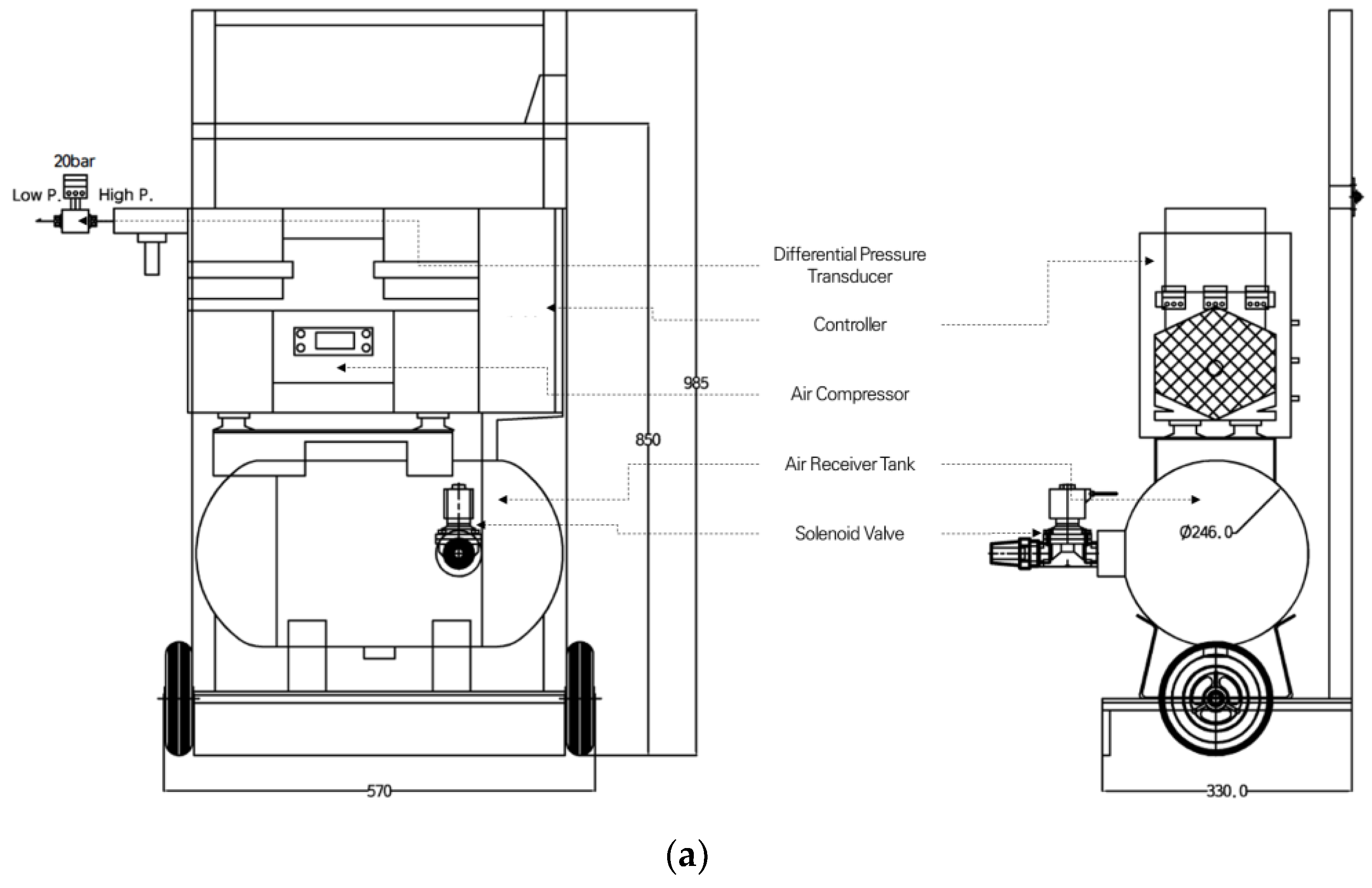
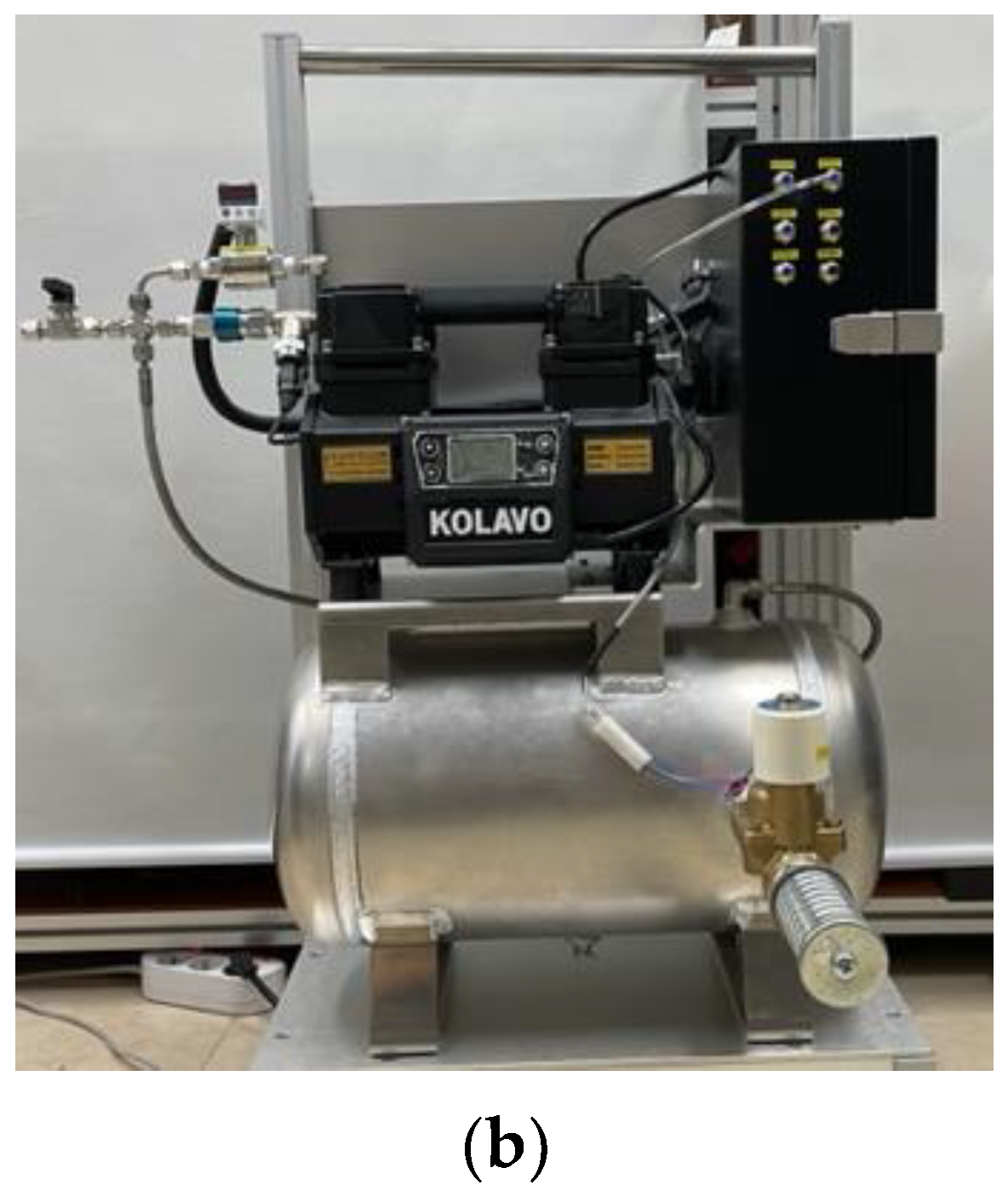
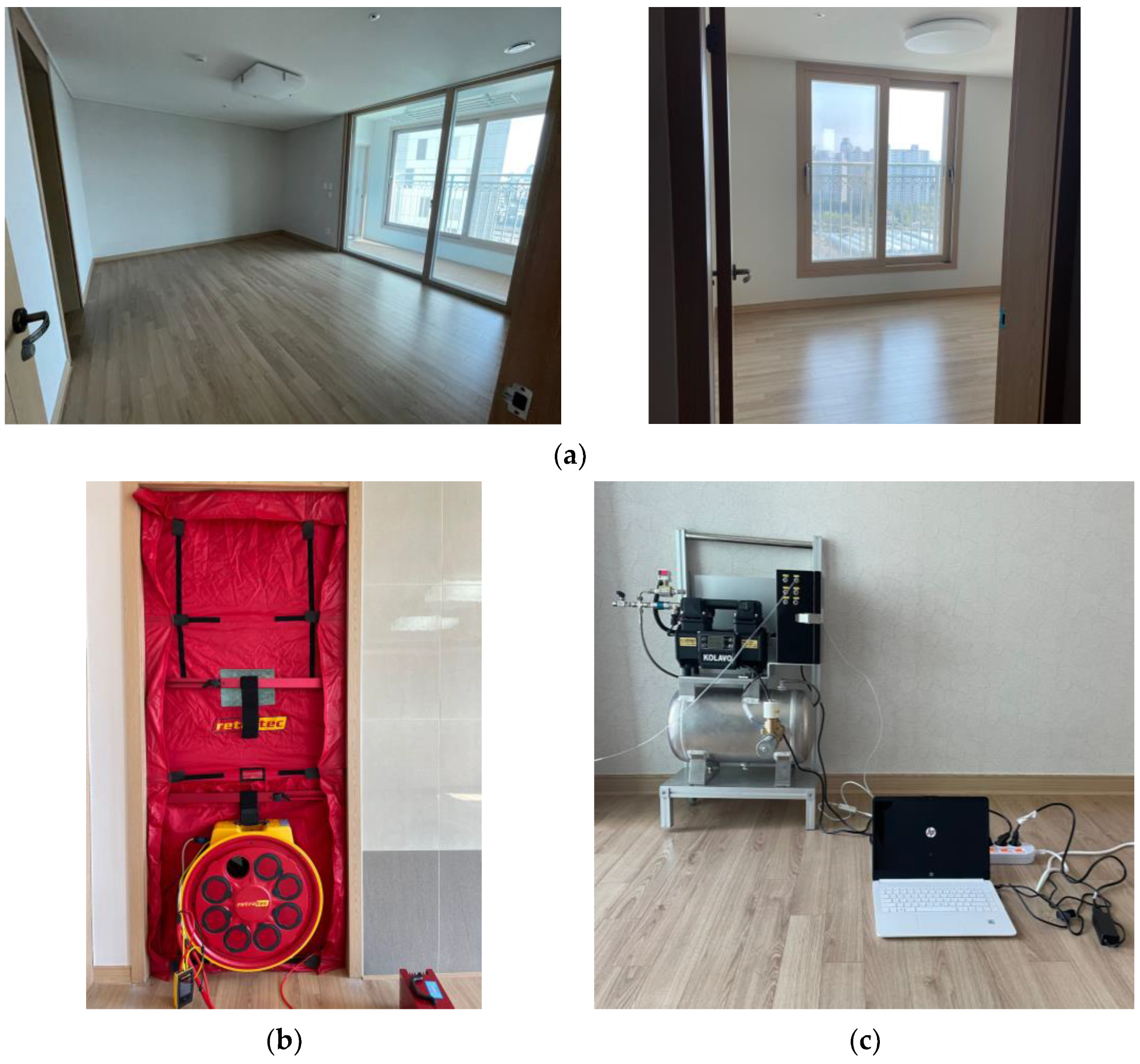
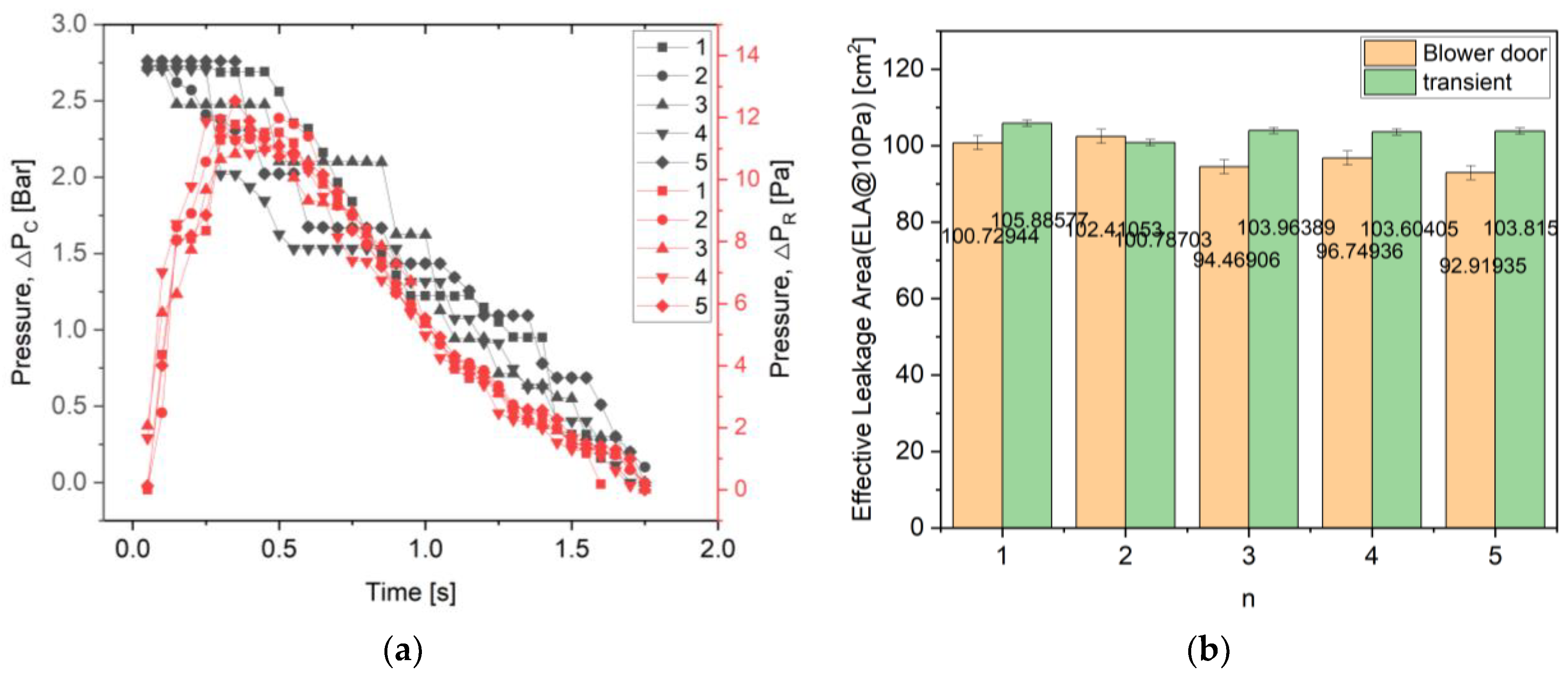
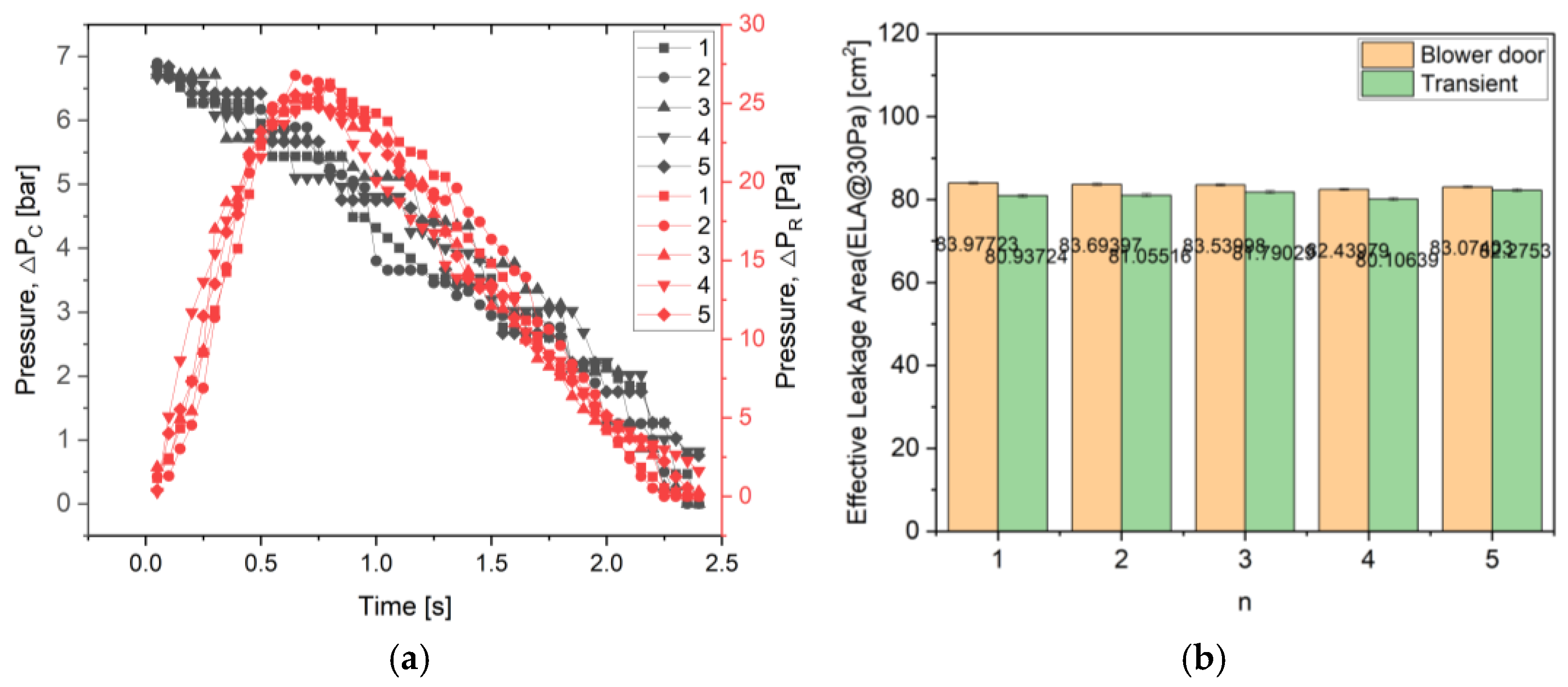


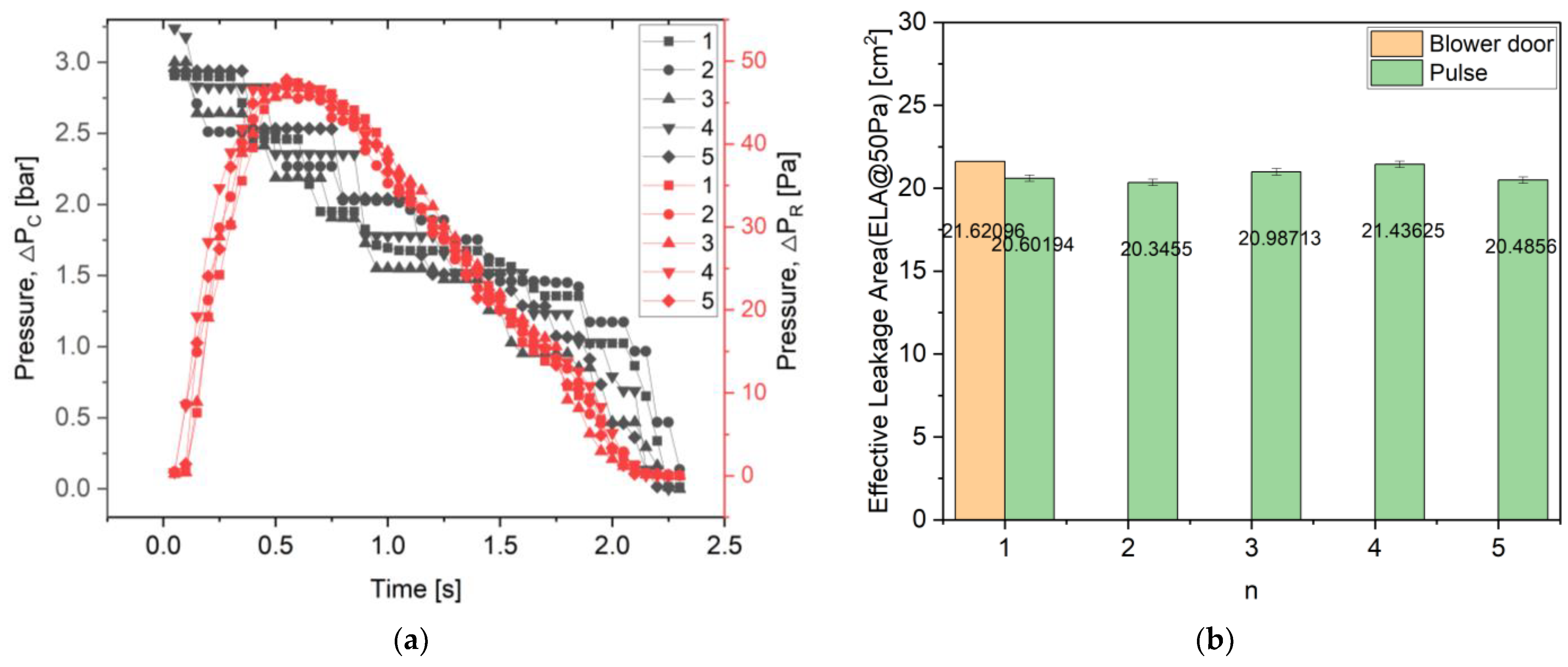
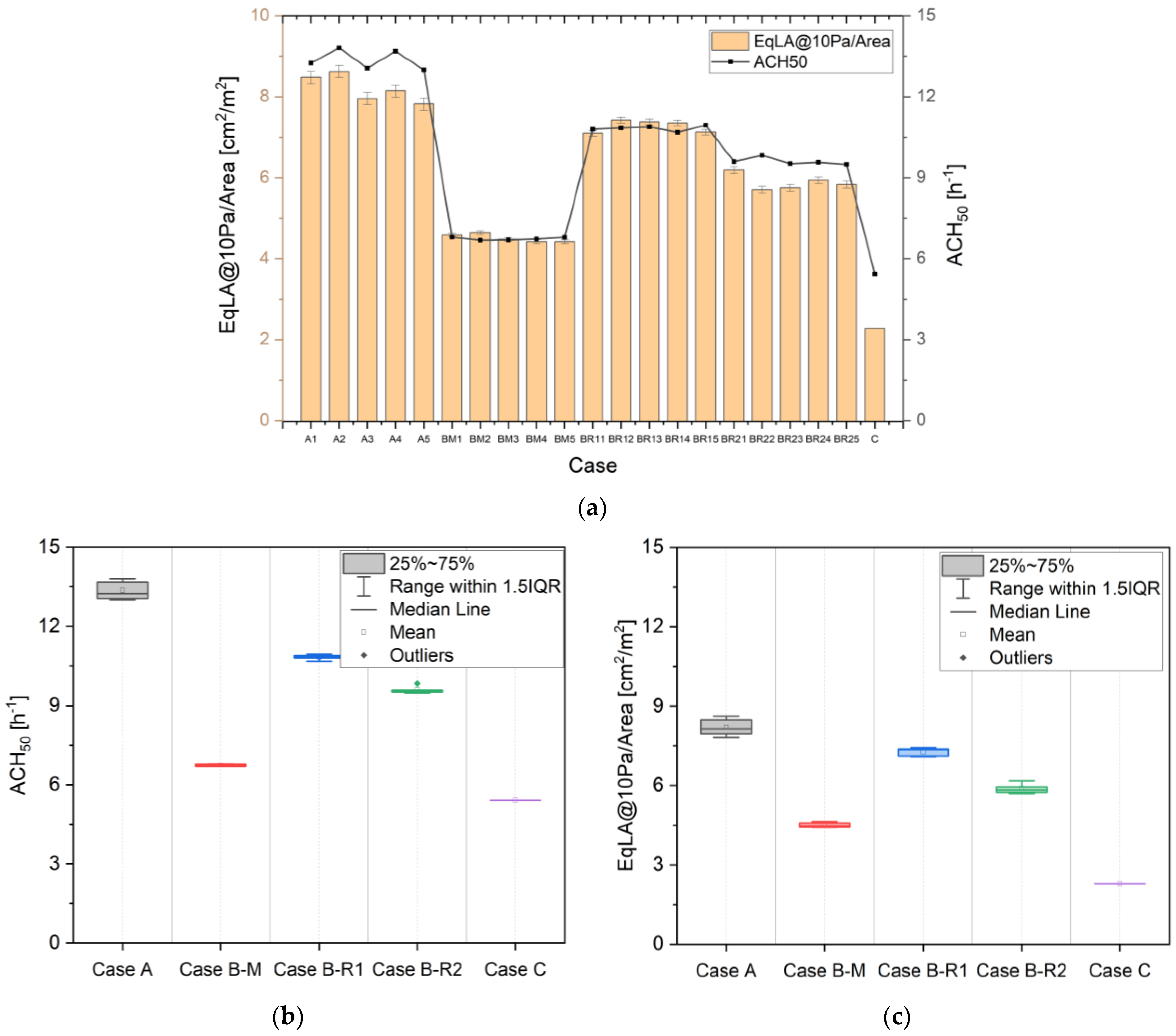
| Component | Parameters | Values |
|---|---|---|
| Gauge | Model | DM32W |
| Pressure range | −2488 Pa to +2488 Pa | |
| Pressure accuracy | ±0.4% of pressure reading or ±0.07 Pa @ 22 degree (C) | |
| Fan | Model | EU6100 |
| Flow accuracy | ±5% |
| Component | Parameters | Values |
|---|---|---|
| Air receiver tank | Model | ALT20 |
| Volume | 20 L | |
| Material | Aluminum | |
| Solenoid valve | Model | HPW 2510-20 |
| Orifice | Ø25 | |
| Pressure | 0.05–2.04 MPa (0.5–20 kgf/cm2) | |
| Air compressor | Model | KOLAVO-DC660 |
| Pressure | 0.3–0.9 MPa | |
| Flow | 125 L/min | |
| Differential pressure transducer | Model | SMA Series |
| Range | 0–3.5 MPa(chamber), 0–100 Pa(room) | |
| Accuracy | ±3% FS (chamber), ±5% FS (room) |
| Component | Residential Building | Non-Residential Building | |
|---|---|---|---|
| Case A | Case B | Case C | |
| Address | Daejeon, Korea | Daejeon, Korea | Daejeon, Korea |
| Experiment floor | 1st | 13th | 1st |
| Structure | Reinforced concrete structure | Reinforced concrete wall structure | Reinforced concrete structure |
| Floor area [m2] | 11.88 | 84.95 (total), 18.04, 10.59, 9.48 (each room) | 6.12 |
| Ceiling height [m] | 2.3 | 2.3 | 2.2 |
| Opening size [m2] | ① Window: 2.1 × 0.6 = 1.26 ② Door: 1.0 × 2.1 = 2.1 | ① Main room: 3.1 × 2.1 = 6.51 ② Room1, 2: 2.0 × 2.1 = 4.2 | Door: 1.0 × 2.1 = 2.1 |
| Date of experiment | 27 January 2021 | 8 April 2021 | 26 August 2020 |
| Division | Floor Area (m2) | ELA@4 Pa (cm2) | EqLA@10 Pa (cm2) | EqLA@10 Pa/Area (cm2/m2) | ACH50 (h−1) | |
|---|---|---|---|---|---|---|
| Case A | 11.88 | 90.23 | 97.46 | 8.2 | 13.36 | |
| Case B | Main room | 18.04 | 79.69 | 81.32 | 4.51 | 6.74 |
| Room 1 | 9.48 | 67.68 | 68.97 | 7.28 | 10.83 | |
| Room 2 | 10.59 | 57.79 | 62.29 | 5.88 | 9.60 | |
| Case C | 6.12 | 10.89 | 13.96 | 2.28 | 5.43 | |
Disclaimer/Publisher’s Note: The statements, opinions and data contained in all publications are solely those of the individual author(s) and contributor(s) and not of MDPI and/or the editor(s). MDPI and/or the editor(s) disclaim responsibility for any injury to people or property resulting from any ideas, methods, instructions or products referred to in the content. |
© 2023 by the authors. Licensee MDPI, Basel, Switzerland. This article is an open access article distributed under the terms and conditions of the Creative Commons Attribution (CC BY) license (https://creativecommons.org/licenses/by/4.0/).
Share and Cite
Han, S.; Jeong, H.; Lee, J.; Kim, J. In Situ Airtightness Measurement Using Compressed Air Flow Characteristics. Energies 2023, 16, 6975. https://doi.org/10.3390/en16196975
Han S, Jeong H, Lee J, Kim J. In Situ Airtightness Measurement Using Compressed Air Flow Characteristics. Energies. 2023; 16(19):6975. https://doi.org/10.3390/en16196975
Chicago/Turabian StyleHan, Seolyee, Hakgeun Jeong, Jinsook Lee, and Jonghun Kim. 2023. "In Situ Airtightness Measurement Using Compressed Air Flow Characteristics" Energies 16, no. 19: 6975. https://doi.org/10.3390/en16196975
APA StyleHan, S., Jeong, H., Lee, J., & Kim, J. (2023). In Situ Airtightness Measurement Using Compressed Air Flow Characteristics. Energies, 16(19), 6975. https://doi.org/10.3390/en16196975







